Andrea Bajcsy
Adapting by Analogy: OOD Generalization of Visuomotor Policies via Functional Correspondence
Jun 15, 2025Abstract:End-to-end visuomotor policies trained using behavior cloning have shown a remarkable ability to generate complex, multi-modal low-level robot behaviors. However, at deployment time, these policies still struggle to act reliably when faced with out-of-distribution (OOD) visuals induced by objects, backgrounds, or environment changes. Prior works in interactive imitation learning solicit corrective expert demonstrations under the OOD conditions -- but this can be costly and inefficient. We observe that task success under OOD conditions does not always warrant novel robot behaviors. In-distribution (ID) behaviors can directly be transferred to OOD conditions that share functional similarities with ID conditions. For example, behaviors trained to interact with in-distribution (ID) pens can apply to interacting with a visually-OOD pencil. The key challenge lies in disambiguating which ID observations functionally correspond to the OOD observation for the task at hand. We propose that an expert can provide this OOD-to-ID functional correspondence. Thus, instead of collecting new demonstrations and re-training at every OOD encounter, our method: (1) detects the need for feedback by first checking if current observations are OOD and then identifying whether the most similar training observations show divergent behaviors, (2) solicits functional correspondence feedback to disambiguate between those behaviors, and (3) intervenes on the OOD observations with the functionally corresponding ID observations to perform deployment-time generalization. We validate our method across diverse real-world robotic manipulation tasks with a Franka Panda robotic manipulator. Our results show that test-time functional correspondences can improve the generalization of a vision-based diffusion policy to OOD objects and environment conditions with low feedback.
Uncertainty-aware Latent Safety Filters for Avoiding Out-of-Distribution Failures
May 01, 2025Abstract:Recent advances in generative world models have enabled classical safe control methods, such as Hamilton-Jacobi (HJ) reachability, to generalize to complex robotic systems operating directly from high-dimensional sensor observations. However, obtaining comprehensive coverage of all safety-critical scenarios during world model training is extremely challenging. As a result, latent safety filters built on top of these models may miss novel hazards and even fail to prevent known ones, overconfidently misclassifying risky out-of-distribution (OOD) situations as safe. To address this, we introduce an uncertainty-aware latent safety filter that proactively steers robots away from both known and unseen failures. Our key idea is to use the world model's epistemic uncertainty as a proxy for identifying unseen potential hazards. We propose a principled method to detect OOD world model predictions by calibrating an uncertainty threshold via conformal prediction. By performing reachability analysis in an augmented state space-spanning both the latent representation and the epistemic uncertainty-we synthesize a latent safety filter that can reliably safeguard arbitrary policies from both known and unseen safety hazards. In simulation and hardware experiments on vision-based control tasks with a Franka manipulator, we show that our uncertainty-aware safety filter preemptively detects potential unsafe scenarios and reliably proposes safe, in-distribution actions. Video results can be found on the project website at https://cmu-intentlab.github.io/UNISafe
A Unified Framework for Robots that Influence Humans over Long-Term Interaction
Mar 18, 2025Abstract:Robot actions influence the decisions of nearby humans. Here influence refers to intentional change: robots influence humans when they shift the human's behavior in a way that helps the robot complete its task. Imagine an autonomous car trying to merge; by proactively nudging into the human's lane, the robot causes human drivers to yield and provide space. Influence is often necessary for seamless interaction. However, if influence is left unregulated and uncontrolled, robots will negatively impact the humans around them. Prior works have begun to address this problem by creating a variety of control algorithms that seek to influence humans. Although these methods are effective in the short-term, they fail to maintain influence over time as the human adapts to the robot's behaviors. In this paper we therefore present an optimization framework that enables robots to purposely regulate their influence over humans across both short-term and long-term interactions. Here the robot maintains its influence by reasoning over a dynamic human model which captures how the robot's current choices will impact the human's future behavior. Our resulting framework serves to unify current approaches: we demonstrate that state-of-the-art methods are simplifications of our underlying formalism. Our framework also provides a principled way to generate influential policies: in the best case the robot exactly solves our framework to find optimal, influential behavior. But when solving this optimization problem becomes impractical, designers can introduce their own simplifications to reach tractable approximations. We experimentally compare our unified framework to state-of-the-art baselines and ablations, and demonstrate across simulations and user studies that this framework is able to successfully influence humans over repeated interactions. See videos of our experiments here: https://youtu.be/nPekTUfUEbo
From Foresight to Forethought: VLM-In-the-Loop Policy Steering via Latent Alignment
Feb 03, 2025Abstract:While generative robot policies have demonstrated significant potential in learning complex, multimodal behaviors from demonstrations, they still exhibit diverse failures at deployment-time. Policy steering offers an elegant solution to reducing the chance of failure by using an external verifier to select from low-level actions proposed by an imperfect generative policy. Here, one might hope to use a Vision Language Model (VLM) as a verifier, leveraging its open-world reasoning capabilities. However, off-the-shelf VLMs struggle to understand the consequences of low-level robot actions as they are represented fundamentally differently than the text and images the VLM was trained on. In response, we propose FOREWARN, a novel framework to unlock the potential of VLMs as open-vocabulary verifiers for runtime policy steering. Our key idea is to decouple the VLM's burden of predicting action outcomes (foresight) from evaluation (forethought). For foresight, we leverage a latent world model to imagine future latent states given diverse low-level action plans. For forethought, we align the VLM with these predicted latent states to reason about the consequences of actions in its native representation--natural language--and effectively filter proposed plans. We validate our framework across diverse robotic manipulation tasks, demonstrating its ability to bridge representational gaps and provide robust, generalizable policy steering.
Generalizing Safety Beyond Collision-Avoidance via Latent-Space Reachability Analysis
Feb 02, 2025Abstract:Hamilton-Jacobi (HJ) reachability is a rigorous mathematical framework that enables robots to simultaneously detect unsafe states and generate actions that prevent future failures. While in theory, HJ reachability can synthesize safe controllers for nonlinear systems and nonconvex constraints, in practice, it has been limited to hand-engineered collision-avoidance constraints modeled via low-dimensional state-space representations and first-principles dynamics. In this work, our goal is to generalize safe robot controllers to prevent failures that are hard -- if not impossible -- to write down by hand, but can be intuitively identified from high-dimensional observations: for example, spilling the contents of a bag. We propose Latent Safety Filters, a latent-space generalization of HJ reachability that tractably operates directly on raw observation data (e.g., RGB images) by performing safety analysis in the latent embedding space of a generative world model. This transforms nuanced constraint specification to a classification problem in latent space and enables reasoning about dynamical consequences that are hard to simulate. In simulation and hardware experiments, we use Latent Safety Filters to safeguard arbitrary policies (from generative policies to direct teleoperation) from complex safety hazards, like preventing a Franka Research 3 manipulator from spilling the contents of a bag or toppling cluttered objects.
Your Learned Constraint is Secretly a Backward Reachable Tube
Jan 26, 2025Abstract:Inverse Constraint Learning (ICL) is the problem of inferring constraints from safe (i.e., constraint-satisfying) demonstrations. The hope is that these inferred constraints can then be used downstream to search for safe policies for new tasks and, potentially, under different dynamics. Our paper explores the question of what mathematical entity ICL recovers. Somewhat surprisingly, we show that both in theory and in practice, ICL recovers the set of states where failure is inevitable, rather than the set of states where failure has already happened. In the language of safe control, this means we recover a backwards reachable tube (BRT) rather than a failure set. In contrast to the failure set, the BRT depends on the dynamics of the data collection system. We discuss the implications of the dynamics-conditionedness of the recovered constraint on both the sample-efficiency of policy search and the transferability of learned constraints.
Maximizing Alignment with Minimal Feedback: Efficiently Learning Rewards for Visuomotor Robot Policy Alignment
Dec 06, 2024
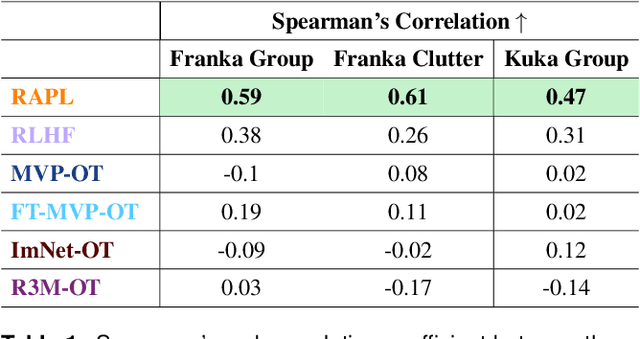

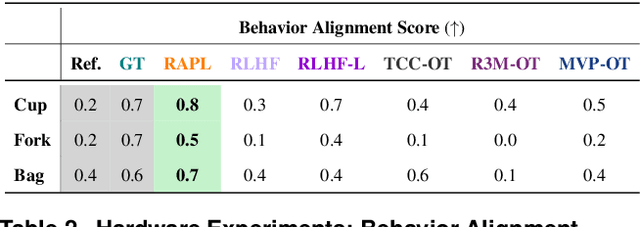
Abstract:Visuomotor robot policies, increasingly pre-trained on large-scale datasets, promise significant advancements across robotics domains. However, aligning these policies with end-user preferences remains a challenge, particularly when the preferences are hard to specify. While reinforcement learning from human feedback (RLHF) has become the predominant mechanism for alignment in non-embodied domains like large language models, it has not seen the same success in aligning visuomotor policies due to the prohibitive amount of human feedback required to learn visual reward functions. To address this limitation, we propose Representation-Aligned Preference-based Learning (RAPL), an observation-only method for learning visual rewards from significantly less human preference feedback. Unlike traditional RLHF, RAPL focuses human feedback on fine-tuning pre-trained vision encoders to align with the end-user's visual representation and then constructs a dense visual reward via feature matching in this aligned representation space. We first validate RAPL through simulation experiments in the X-Magical benchmark and Franka Panda robotic manipulation, demonstrating that it can learn rewards aligned with human preferences, more efficiently uses preference data, and generalizes across robot embodiments. Finally, our hardware experiments align pre-trained Diffusion Policies for three object manipulation tasks. We find that RAPL can fine-tune these policies with 5x less real human preference data, taking the first step towards minimizing human feedback while maximizing visuomotor robot policy alignment.
Agent-to-Sim: Learning Interactive Behavior Models from Casual Longitudinal Videos
Oct 21, 2024Abstract:We present Agent-to-Sim (ATS), a framework for learning interactive behavior models of 3D agents from casual longitudinal video collections. Different from prior works that rely on marker-based tracking and multiview cameras, ATS learns natural behaviors of animal and human agents non-invasively through video observations recorded over a long time-span (e.g., a month) in a single environment. Modeling 3D behavior of an agent requires persistent 3D tracking (e.g., knowing which point corresponds to which) over a long time period. To obtain such data, we develop a coarse-to-fine registration method that tracks the agent and the camera over time through a canonical 3D space, resulting in a complete and persistent spacetime 4D representation. We then train a generative model of agent behaviors using paired data of perception and motion of an agent queried from the 4D reconstruction. ATS enables real-to-sim transfer from video recordings of an agent to an interactive behavior simulator. We demonstrate results on pets (e.g., cat, dog, bunny) and human given monocular RGBD videos captured by a smartphone.
Conformalized Interactive Imitation Learning: Handling Expert Shift and Intermittent Feedback
Oct 11, 2024Abstract:In interactive imitation learning (IL), uncertainty quantification offers a way for the learner (i.e. robot) to contend with distribution shifts encountered during deployment by actively seeking additional feedback from an expert (i.e. human) online. Prior works use mechanisms like ensemble disagreement or Monte Carlo dropout to quantify when black-box IL policies are uncertain; however, these approaches can lead to overconfident estimates when faced with deployment-time distribution shifts. Instead, we contend that we need uncertainty quantification algorithms that can leverage the expert human feedback received during deployment time to adapt the robot's uncertainty online. To tackle this, we draw upon online conformal prediction, a distribution-free method for constructing prediction intervals online given a stream of ground-truth labels. Human labels, however, are intermittent in the interactive IL setting. Thus, from the conformal prediction side, we introduce a novel uncertainty quantification algorithm called intermittent quantile tracking (IQT) that leverages a probabilistic model of intermittent labels, maintains asymptotic coverage guarantees, and empirically achieves desired coverage levels. From the interactive IL side, we develop ConformalDAgger, a new approach wherein the robot uses prediction intervals calibrated by IQT as a reliable measure of deployment-time uncertainty to actively query for more expert feedback. We compare ConformalDAgger to prior uncertainty-aware DAgger methods in scenarios where the distribution shift is (and isn't) present because of changes in the expert's policy. We find that in simulated and hardware deployments on a 7DOF robotic manipulator, ConformalDAgger detects high uncertainty when the expert shifts and increases the number of interventions compared to baselines, allowing the robot to more quickly learn the new behavior.
Updating Robot Safety Representations Online from Natural Language Feedback
Sep 22, 2024
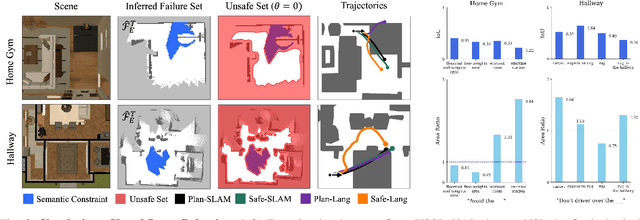
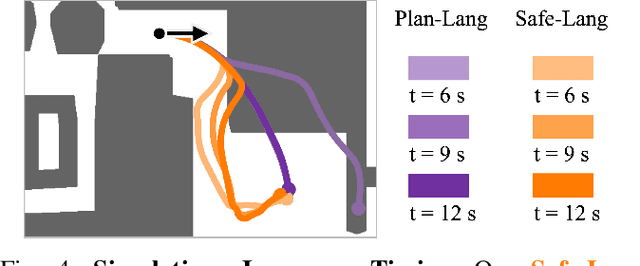
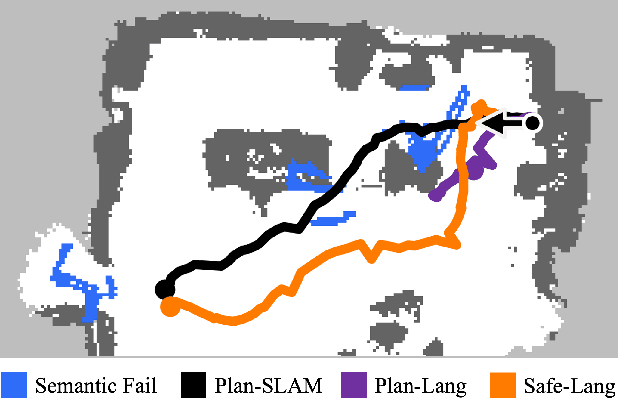
Abstract:Robots must operate safely when deployed in novel and human-centered environments, like homes. Current safe control approaches typically assume that the safety constraints are known a priori, and thus, the robot can pre-compute a corresponding safety controller. While this may make sense for some safety constraints (e.g., avoiding collision with walls by analyzing a floor plan), other constraints are more complex (e.g., spills), inherently personal, context-dependent, and can only be identified at deployment time when the robot is interacting in a specific environment and with a specific person (e.g., fragile objects, expensive rugs). Here, language provides a flexible mechanism to communicate these evolving safety constraints to the robot. In this work, we use vision language models (VLMs) to interpret language feedback and the robot's image observations to continuously update the robot's representation of safety constraints. With these inferred constraints, we update a Hamilton-Jacobi reachability safety controller online via efficient warm-starting techniques. Through simulation and hardware experiments, we demonstrate the robot's ability to infer and respect language-based safety constraints with the proposed approach.
 Add to Chrome
Add to Chrome Add to Firefox
Add to Firefox Add to Edge
Add to Edge